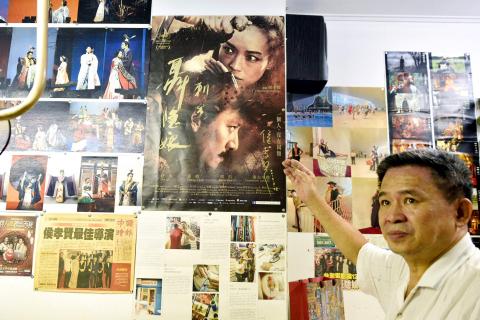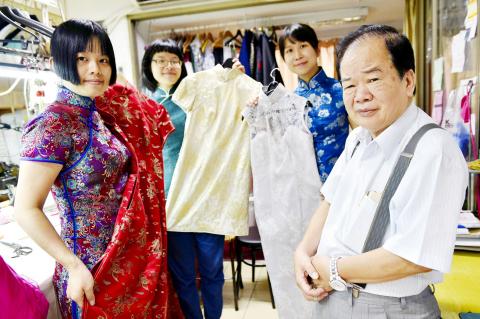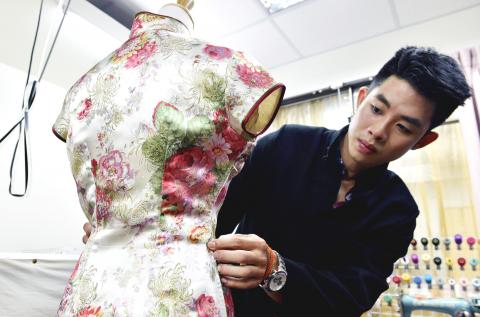In a quiet workshop in Taipei, three young women meticulously sew and iron under the watchful eye of a master dressmaker with decades of experience in creating the classic qipao.
Lin Chin-te (林錦德), 74, is among a handful of craftsmen in Taiwan who still specialize in handmaking the high-collar, figure-hugging garment which was once part of many women’s daily wardrobes.
His workshop is hung with dresses, from elaborate long embroidered red silk qipaos to shorter length versions in more wearable materials.

photo: AFP
Seen as increasingly impractical and pricier than off-the-peg versions, the tailormade qipao is now mostly worn at weddings and special events. Lin worries dressmakers will no longer learn his skills and takes on apprentices to pass down his know-how.
Hung Chu-tsu, 37, is one of Lin’s three 30-something female pupils.
“The master is very patient,” she says, wearing a knee-length blue floral qipao she made herself. “We start practicing from the basics and learn one stitch at a time.”

photo: AFP
Hung says she thinks qipaos are beautiful and left her career as a nurse to learn to be a dressmaker after having a child.
Her plan is to open her own shop, selling handmade qipaos adapted to a modern life. Often smiling, with braces holding up his trousers and a thimble wedged on his middle finger, Lin says he wants to ensure his 60 years of experience do not go to waste.
“I teach my pupils as much as I can and hopefully they can strike out on their own in the future,” he says.

photo: AFP
“QIPAO HUNK”
The qipao — meaning “Qi robe” — began as a long, loose dress worn by the Manchus or “Qi” people who ruled China from the 17th century to the early 1900s. Its popularity took off in 1920s Shanghai when it was modified into a fitted must-have, favored by actresses and intellectuals as a symbol of femininity and refinement.
Also known as cheongsam in Cantonese, it fell out of favor in China after communist forces seized power in 1949 following the Chinese Civil War and the dress became associated with capitalism.
But the qipao gained a following in Taiwan, where defeated Chinese Nationalist Party (KMT) leader Chiang Kai-shek (將介石) set up a separate government after fleeing China. Chiang’s glamorous wife Soong Mei-ling (宋美齡) belonged to Shanghai high society and was a qipao enthusiast, influencing trends in Taiwan. Many women wore the dress daily until the 1970s.
Mass-produced, cheaper clothes eventually dented its appeal and some designers say recent growing anti-China sentiment has also put off young people as they associate the dress with that country’s culture. However, Lee Wei-fan (李威樊), 25, says there is still a fanbase. He studied qipao making under an old master for five years after deciding to carve out a niche in a field few of his design peers wanted to go into. Lee opened his own business six months ago and has built a following on social media where he goes under the name “Qipao Hunk” — something he blushes to admit was a publicity stunt.
His clients range from brides to businesswomen who see the dress as elegant. Lee says there is increasing interest in traditional Asian styles, which he hopes to tap into.
“Those of us who have a rarer craft will be more competitive,” he says.
Neither Lin nor Lee would reveal their prices but a master dressmaker charges from around US$260, not including the price of fabric.
CINEMATIC APPEAL
Arguably Taiwan’s most famous qipao maker, Chen Chung-hsin (陳忠信), 65, regularly opens up his modest workshop to tour groups and school trips to build enthusiasm for qipao making. Known for creating costumes for movies including Taiwanese director Hou Hsiao-hsien’s (侯孝賢) Cannes-winning martial arts epic The Assassin, Chen learned his skills from his father and inherited his shop. He says he makes qipaos “with a happy heart” for his clients.
“I hope that more people will see the traditional tailormade qipao is different from an off-the-peg one — mine flatters their shapes more,” says Chen. One of his loyal clients, Taipei marketing executive Yogi Ma, has set up a qipao club aimed at making the classic dress a daily wardrobe staple once more, saying it can suit any figure and can be modernized using different cuts and fabrics.
“The qipao is very elegant and pretty, it’s a pity that fewer women wear them now,” says Ma, 42, who sees it as representing the “beauty of ethnic Chinese women.”
Her Facebook-based club has over 4,000 followers and arranges events where members wear the dress to take part in activities, from whiskey tasting to flower arranging. She hopes that by promoting the dress she will help skills like Chen’s survive.
“If more people like the qipao, there won’t be an issue of lacking people to learn the craft,” she said.

Taiwan Power Co (Taipower, 台電) and the New Taipei City Government in May last year agreed to allow the activation of a spent fuel storage facility for the Jinshan Nuclear Power Plant in Shihmen District (石門). The deal ended eleven years of legal wrangling. According to the Taipower announcement, the city government engaged in repeated delays, failing to approve water and soil conservation plans. Taipower said at the time that plans for another dry storage facility for the Guosheng Nuclear Power Plant in New Taipei City’s Wanli District (萬里) remained stuck in legal limbo. Later that year an agreement was reached

What does the Taiwan People’s Party (TPP) in the Huang Kuo-chang (黃國昌) era stand for? What sets it apart from their allies, the Chinese Nationalist Party (KMT)? With some shifts in tone and emphasis, the KMT’s stances have not changed significantly since the late 2000s and the era of former president Ma Ying-jeou (馬英九). The Democratic Progressive Party’s (DPP) current platform formed in the mid-2010s under the guidance of Tsai Ing-wen (蔡英文), and current President William Lai (賴清德) campaigned on continuity. Though their ideological stances may be a bit stale, they have the advantage of being broadly understood by the voters.

In a high-rise office building in Taipei’s government district, the primary agency for maintaining links to Thailand’s 108 Yunnan villages — which are home to a population of around 200,000 descendants of the Chinese Nationalist Party (KMT) armies stranded in Thailand following the Chinese Civil War — is the Overseas Community Affairs Council (OCAC). Established in China in 1926, the OCAC was born of a mandate to support Chinese education, culture and economic development in far flung Chinese diaspora communities, which, especially in southeast Asia, had underwritten the military insurgencies against the Qing Dynasty that led to the founding of

Artifacts found at archeological sites in France and Spain along the Bay of Biscay shoreline show that humans have been crafting tools from whale bones since more than 20,000 years ago, illustrating anew the resourcefulness of prehistoric people. The tools, primarily hunting implements such as projectile points, were fashioned from the bones of at least five species of large whales, the researchers said. Bones from sperm whales were the most abundant, followed by fin whales, gray whales, right or bowhead whales — two species indistinguishable with the analytical method used in the study — and blue whales. With seafaring capabilities by humans